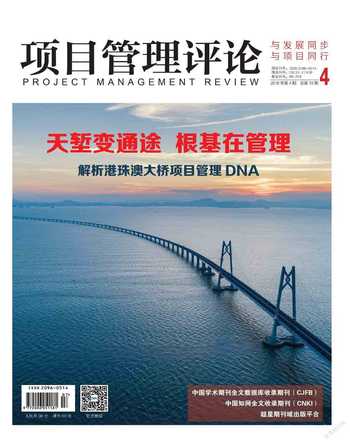绿色项目管理:时代所向
尉艳娟
古人云:“竭泽而渔,非不得鱼,明年无鱼;焚林而畋,非不获兽,明年无兽矣。”面对日益严峻的资源、污染问题,可持续发展已成为时代的主流和呼唤。靠高消耗和高污染来做项目与时代背道而驰。
项目是一种变革工具,社会的可持续发展需要通过绿色项目管理来实现。项目管理者需要将可持续性理念融入整个项目生命周期。
项目管理在发展,项目管理人的视角需不断延伸,我们不应只关心项目管理四要素,还需考虑项目管理过程的生态、社会、经济足迹。传统的项目管理与绿色项目管理有何区别?如何才能让可持续性的理念贯串项目管理的整个生命周期?如何对项目管理的可持续性进行评估?如何用可持续性的眼光看待项目风险和机会?可持续项目管理有何衡量标准?带着这些疑问,我们采访了绿色项目管理全球组织(GPM Global)的创始人乔尔·卡尔博尼(Joel Carboni)。
乔尔·卡尔博尼,博士学位,从业20余年,IPMA美国分会主席,绿色项目管理全球组织的创始人,PRiSM项目管理方法架构师,《绿色项目管理参考指南》(GPM Reference Guide)作者之一。
绿色项目管理全球组织是倡导可持续性项目管理的全球性组织,该组织设立了可持续性项目管理的标准(P5)、方法模型(PRiSM)、认证(三个级别)。PRiSM从建模的角度,通过利用现有的组织系统来确保项目实现水平和垂直收益,并将重点放在过程和产品的可持续性上,从而使项目更具战略意义。
乔尔·卡尔博尼强调,绿色项目管理,就是不仅要关注项目的投入、产出、流程,更要关注项目管理对社会、环境、宏观和微观经济的影响。
乔尔·卡爾博尼认为,要把可持续性融入项目中,首先要建立以收益为导向的思维模式,做好可持续性管理规划。对于企业而言,可持续性管理的第一步是设立可持续性目标,然后把服务于这些目标的项目管理实践融入项目治理中。
一项针对103个国家27个行业的1 000名CEO的调查显示,93%的CEO认为可持续性对成功至关重要。在全球市场上,可持续性已被看成是“必需品”。正如乔尔·卡尔博尼所说,项目管理是一座桥,将项目与可持续发展这一宏伟目标连接在一起。我们有理由相信,绿色项目管理将成为时代主流。
Interview
As founder of GPM (Green Project Management) Global, you are at the forefront of sustainability management. As an organization, what is GPM Globals focus? What is “Green Project Management” by definition?
Joel Carboni: The global focus on sustainable development, climate change, ethical behavior, social responsibility, and transparent supply chains has increased in recent years. So have the demands for sustainable business practices. As a supporter of the United Nations Global Compact, GPM views our role in fostering global citizenship, through advocacy for sustainable projects as our primary remit.
We are a global organization that advocates sustainability in the project profession. We help companies become more resilient, governments more efficient, and societies more robust, all while safeguarding our natural resources.
As a social enterprise, we focus on evolving the project profession through principled and value-based methods. From our multiple award-winning standards to our training, assessments, and certifications, our goal is to drive sustainable business and realize the 2030 sustainable development goals (SDGs).
The difference between green/sustainable project management and traditional project management is simply the adherence to a set of principles and looking at project and project management success as more than inputs, outputs, and processes but rather the impacts of what we are doing on society, the environment, and the economy both micro and macro. Globally, humanity is at a crossroads. Problems stemming from humans induced climate change, population increases, lack of potable water, and income & gender inequalities. It is imperative for all professions to self assess what impacts they are making to improve our plant and society for future generations. According to research by Accenture and the UN Global Compact, out of 1,000 global CEOs, from 27 industries across 103 countries, 93% regard sustainability as key to success.
Give us some details on Sustainability Assessment Model and GPM certification, please.
Joel Carboni: From a modeling perspective, our methodology PRiSM which is an acronym for PRojects integrating Sustainable Methods, uses an asset lifecycle approach with a focus on impacts, risks, value and benefits.
PRiSM is a principles-based, sustainable project management methodology. Its key difference from traditional approaches is that it incorporates a value-maximization model that focuses on the total asset lifecycle. PRiSM puts projects into a more strategic focus by leveraging existing organizational systems to ensure that benefits are realized horizontally and vertically, with the utmost attention focused on process and product sustainability.
PRiSM is based on our award winning P5 Standard for Sustainability in Project Management, and is effective in reducing project level risk, from an environmental, social and economic perspective while expanding the range of benefits to be gained. PRiSM extends beyond the typical project lifecyle with a five phased approach that incporporates pre-project planning, product/service adoption and integration as well as benefits realization.
We offer certification globally. Our program is three tiered and begins with the GPM-b (or basic) where a knowledge assessment on sustainability is conducted via exam. This is our most popular certification. From there, we focus on ability in our GPM-s(Specialist) and GPM-m (Master). The Specialist, which is a revamp of what we used to simply call the GPM requires evidence of the integration of sustainable methods with project delivery. This is conducted via case study submittal and in person interview. Our Master-level certification requires advanced experience, and the GPMs case study submittals as well as an academic paper.
We are often asked if our certifications should be sought out instead of a PMI or IPMA certification and while we do assess competence in project management, our certifications are specializations.
About P5 Standard for sustainability in project management, would you please offer us a brief introduction? What does P5 represent?
Joel Carboni: P5 stands for People, Planet, Prosperity, Process and Products. The P5 Standard is a tool that supports the alignment of portfolios, programs, and projects with organizational strategy for sustainability and focuses on the impacts of project processes and deliverables on the environment, society, the corporate bottom line, and the local economy.
Our P5 Standard for sustainability in project management, a free resource, provides guidance on sustainability to ensure benefits maximization and risk mitigation and ties in to the United Nations Sustainable Development Goals (SDGs), thus creating a bridge between all projects to a larger cause.
P5 is not a methodology for how to create the environment, however, it provides the principles or foundation for a methodology such GPMs PRiSM. The P5 Standard represents a structure, as it defines something. The simplest way to explain P5 is that it is made of bonds between the triple bottom line approach, project processes and the resulting products or services.
What kinds of portfolios, programs and projects can be defined as sustainable? Are there any principles to follow?
Joel Carboni: In order to be sustainable, portfolios, programs, and projects should adhere to the following six principles:
1) Commitment & Accountability: Recognize the essential rights of all to healthy, clean and safe environments, equal opportunity, fair remuneration, ethical procurement, and adherence to rule of law.
2) Ethics & Decision Making: Support organizational ethics, decision making with respect for universal principles through identification, mitigation, and the prevention of adverse short and long-term impacts on society and the environment.
3) Integrated & Transparent: Foster the interdependence of economic development, social integrity, and environmental protection in all aspects of governance, practice and reporting. 4) Principles & Values Based: Conserve and enhance our natural resource base by improving the ways in which we develop and use technologies and resources.
5) Social & Ecological Equity: Assess human vulnerability in ecologically sensitive areas and centres of population through demographic dynamics.
6) Economic Prosperity: Adhere to fiscal strategies, objectives, and targets that balance the needs of stakeholders, including immediate needs and those of future generations.
How can we incorporate sustainability into projects? If an enterprise is eager to start sustainable project management, whats your advice for them?
Joel Carboni: The key is to shift to a benefits-focused mindset and to do sustainability management planning. We were very prescriptive of how to do this in our new book Sustainable Project Management: The GPM Reference Guide, but the short of it is to look at risks and opportunities through a sustainable lens. For example, if the project calls for the development of a manufacturing facility, ensure that it makes use of renewable energy as part of the plan and also accounts for any contamination to air, soil, and water. Our P5 standard, which is free from our website, explains this in detail.
For an enterprise interested in initiating green project management, the first step is to determine what the sustainability goals are for the organization. Once they are in place, integrating management practices that contribute to the goals into project governance. As over 30% of the worlds GDP is directly related to project work, there are tremendous opportunities for organizations to benefit from doing so.
Would you please suggest a way to integrate more sustainable methods into our existing project management approaches?
Joel Carboni: Whether it is an Agile approach, Waterfall method or something else, all of them, in order to be effective, must be tailored to the organization. All projects have a business case and the objectives for sustainability the projects product should be included. We advocate the use of a sustainability management plan or SMP which ties organizational and project objectives for sustainability together and focuses on risk and opportunities that might otherwise go unnoticed.
How can we sell a sustainable project management approach to our customers?
Joel Carboni: Every Executive has sustainability on their radar. They know it is important and that the global market has shifted to see sustainability as a necessity. Their challenge is how to implement it. I wouldnt so much as“sell” it to customers but rather make them aware that there are sustainable project practices available that can increase benefits, reduce risks and ensure as sustainable production as possible. It essentially sells itself.
What are the challenges or barriers in promoting PM sustainability?
Joel Carboni: The barriers are predominantly two-fold. The first is that organizations do not place a high enough value on sustainability from a business process perspective. Due to this, management practices often lack sustainable methods. For example, in a project business case, KPIs for sustainability are rarely included.
The second is that project management has been fixated on time, cost, and scope as the foundational constraints and needs to expand to include risk, value, and benefits that are directly tied to social, environmental, and economic impacts.
Whats your observation about green project management in China?
Joel Carboni: We have had success in China and over the past year, over 40 trainers were certified in Beijing. It is well known that Chinese culture lends to thoughtful and long-term planning, often decades into the future. With China taking the global lead in renewable energy among other sustainability areas, there will be increased demands for project managers who understand how to incorporate sustainability into projects in order to meet some of the goals the country has set. We are ready and eager to support.
As a leading expert on this topic, what do you think of the future of sustainable project management?
Joel Carboni: As the global leader in this topic, we have seen rapid growth in the adoption of our P5 standard for sustainability in project management, which is a good indicator. In 2016, we surveyed over 50,000 individuals from over 100 countries who have downloaded the P5 and 93% of the respondents stated that it helped improve project success. This is a clear marker that sustainable project management is increasing in value and we believe that in the future,“mainstream” project management and sustainable project management will become one and the same.

